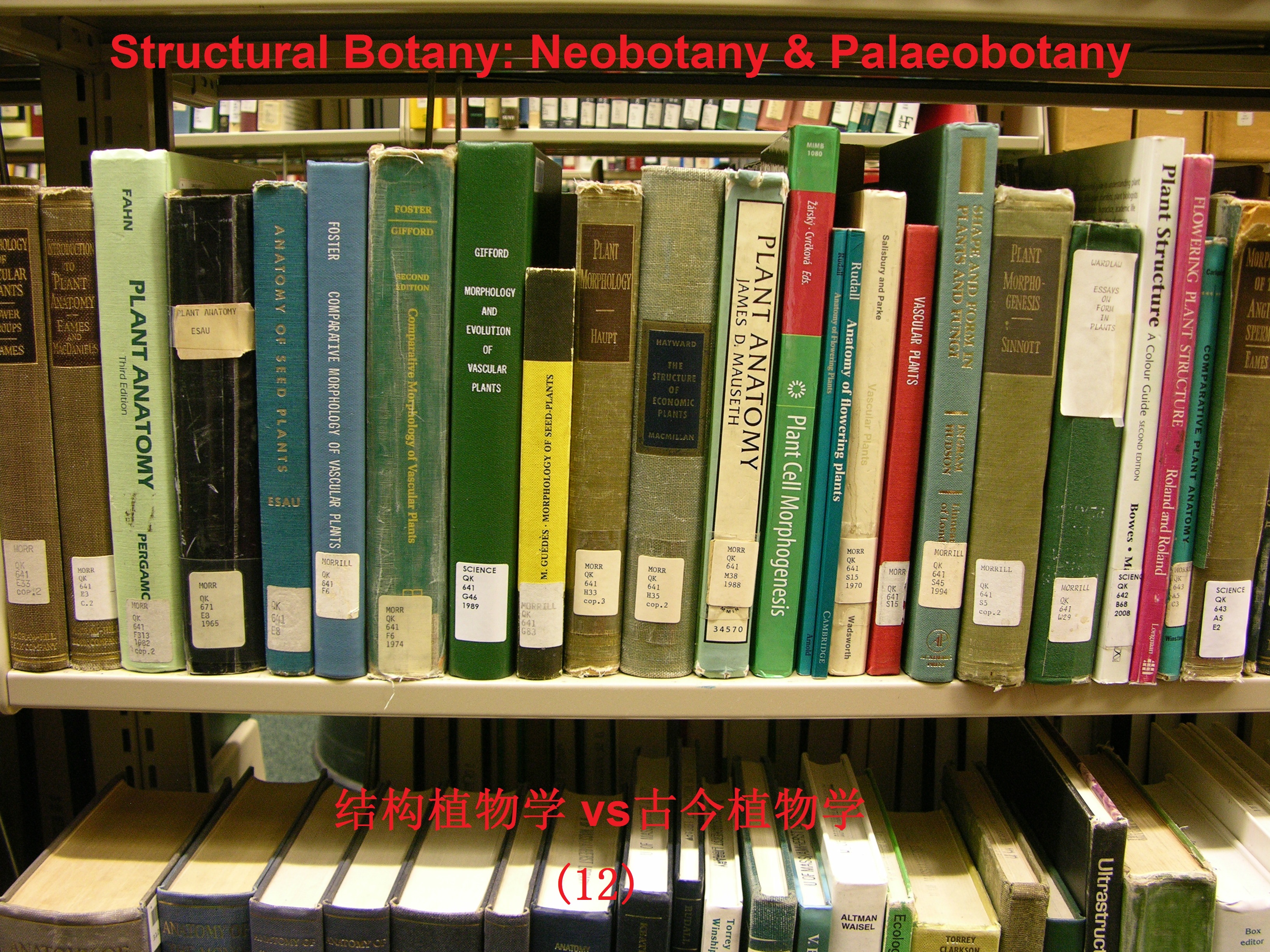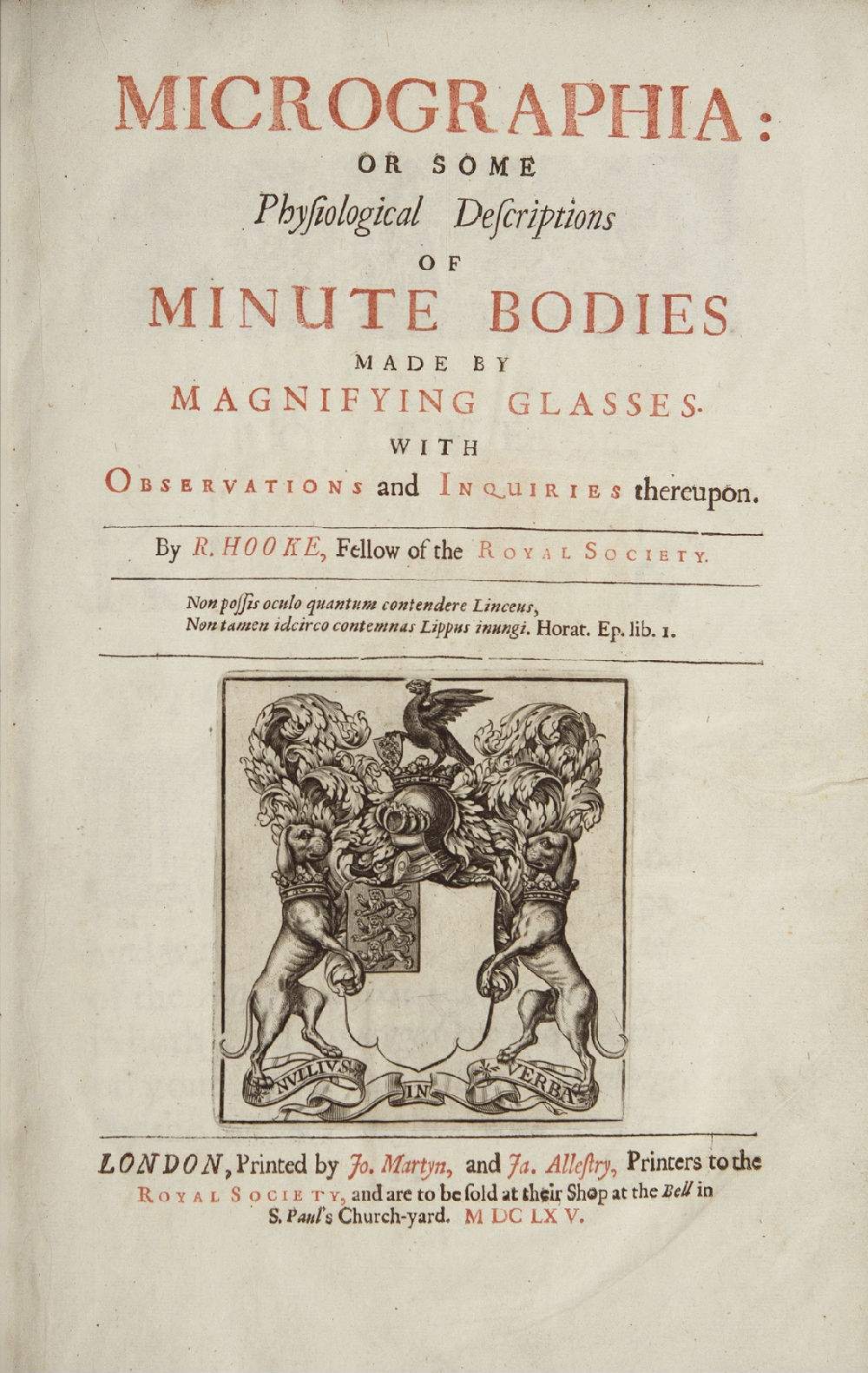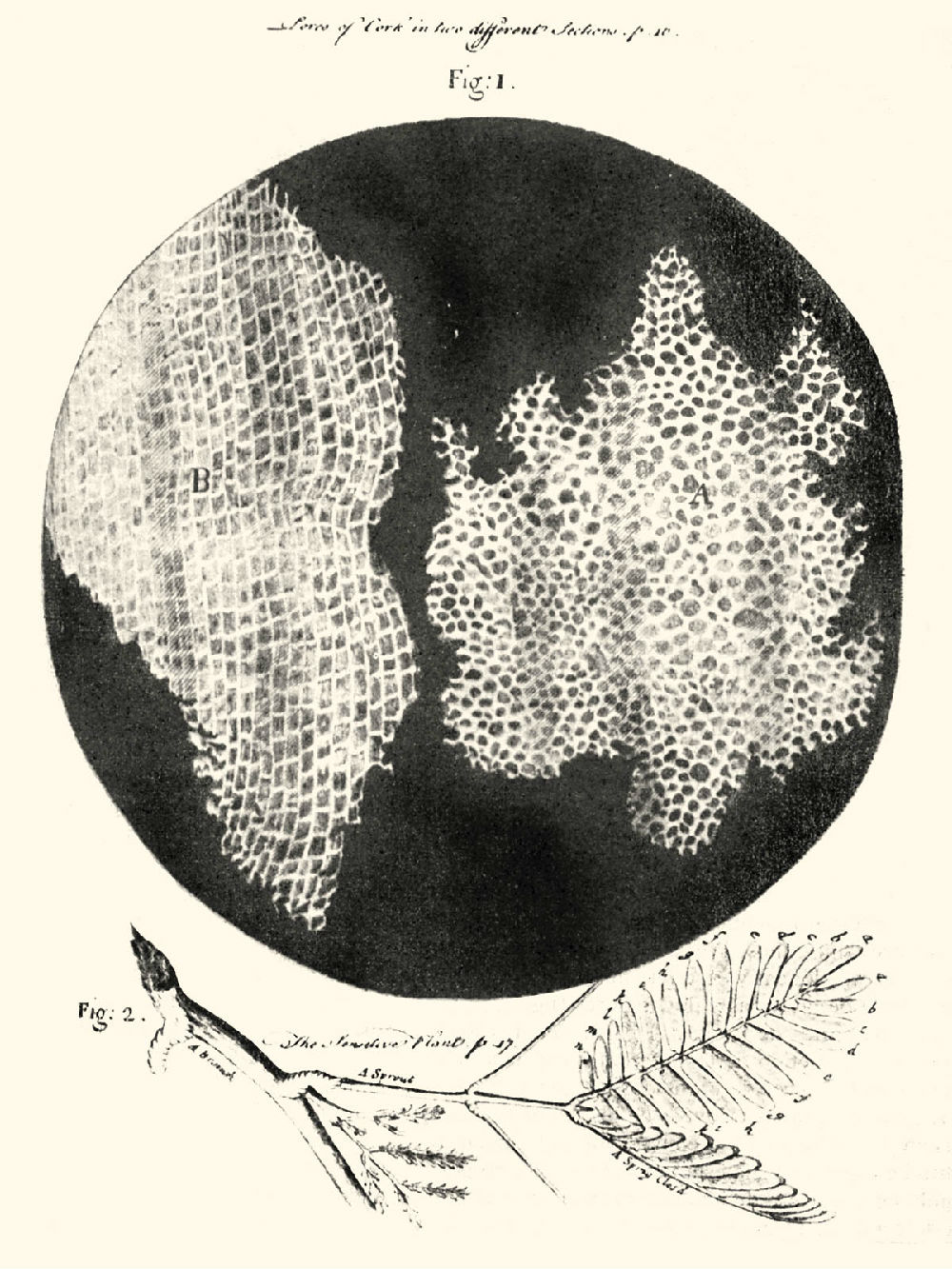博文
Robert Hooke FRS(罗伯特·胡克,1635-1703)与细胞之伟大发现
 精选
精选
|||
Robert Hooke FRS (罗伯特·胡克, 1635—1703)与细胞之伟大发现

17世纪英国物理学家和建筑师Robert Hooke (罗伯特·胡克, 1635—1703)多才多艺,是一位很了不起的人物。可是,他似乎生活在牛顿(Sir Isaac Newton PRS, 1642—1727)的光环下。英国皇家学会(The Royal Society of London)成立于1660年。1663年5月20日,Robert Hooke (罗伯特·胡克)被遴选为英国皇家学会的创始会员(院士)[Original fellow]。牛顿于1672年1月11日进入英国皇家学会。【注:现在,英国皇家学会通常被看作是“英国国家科学院”(The UK’s Academy of Sciences)。】
17世纪初,欧洲出现了光学显微镜,一些人开始摆弄这种时髦“玩具”。1663—1664年间,Robert Hooke利用显微镜对多种小物体进行了大量观察(见附录),并充分发挥了他的绘画天赋绘制了精美的图片。1665年,Robert Hooke用英文发表了《显微图志》(完整英文题目是“Micrographia--Some Physiological Descriptions of Minute Bodies Made by Magnifying Glasses with Observations and Inquiries Thereupon”)。

Fig.1. The title page of Robert Hooke’ s (罗伯特·胡克, 1635—1703) Micrographia
Robert Hooke利用显微镜观察软木片,发现了植物细胞(cell)(“…I could exceeding plainly perceive it to be all perforated and porous, much like a Honey-comb, but that the pores of it were not regular; yet it was not unlike a Honey-comb in these particulars...”)。这是一个伟大的发现!对于Robert Hooke这一科学观察来说,也许这是他科学生涯中的一件小事;但对于植物学(乃至整个生物学)来说,这是一件大事。细胞的发现是人类认识自然的一次大飞跃,是由宏观向微观的大飞跃。
尽管Robert Hooke不是植物学家,但是他用显微镜观察软木片之工作可以被看作是现代木材解剖学的先驱性研究。纵观植物形态解剖学的发展历史,这项工作是一个里程碑。
非常有趣的是Robert Hooke还用显微镜观察了木化石,并与现代木材进行详细的比较。通过仔细的观察对比和严谨分析,Robert Hooke提出了“化石是生物体的遗迹”之科学论断。根据已有的公开文献,我认为,Robert Hooke是利用显微镜观察化石植物的第一人。
【注:荷兰人Antonie Philips van Leeuwenhoek (列文虎克, 1632--1723)利用显微镜观察微生物取得了巨大成就。Antonie Philips van Leeuwenhoek在植物学上也有重要发现,他首次观察了木质部中的孔纹导管(pitted vessel)。Antonie Philips van Leeuwenhoek于1680年1月29日被遴选为英国皇家学会会员。】
-----------------------
Structural Botany-12
OUTLINE: Robert Hooke FRS (罗伯特·胡克, 1635—1703) and the great discovery of cell
Qigao Sun(孙启高)
∮1 Scientific method
Francis Bacon (弗朗西斯·培根, 1561--1626):
Skeptical approach
Observation & experiment
Logic--Inductive reasoning
用质疑态度、通过观察和实验、运用归纳法认识世界
重复性:证实与证伪
Reproducibility (Repeatability): Verification or Falsifiability
∮2 Neobotany & palaeobotany
Structural botany vs evolution:
Gross morphology
Micro-structure morphology
Ultrastructural morphology (超微结构)
关于现代植物学和古植物学研究的重复性问题:如何证实?如何证伪?
∮3 Microscopes
Light / Optical Microscope
Scanning Electron Microscope—SEM
Transmission Electron Microscope—TEM
Synchrotron Radiation X-ray Tomographic Microscopy—SRXTM
The application of SRXTM to fossil plants:
Friis, E.M., Crane,P.R., Pedersen, K.R., Bengtson, S., Donoghue, P. C. J., Grimm, G. W. &Stampanoni, M., 2007. Phase-contrast X-ray microtomography links
Cretaceous seeds with Gnetales andBennettitales. Nature 450: 549-552.
Friis, E. M., Marone,F., Pedersen, K.R., Crane, P.R. and Stampanoni, M., 2014. Three-dimensionalvisualisation of fossil flowers, fruits, seeds and other plant remains usingsynchrotron radiation X-ray tomographic microscopy (SRXTM): New insights intoCretaceous plant diversity. Journal of Paleontology 88: 684-701.
Friis, E.M., Pedersen,K.R and Marone, F., 2014. Arcellites punctatus sp. nov.: a newmegaspore from the Early Cretaceous of Portugal studied using high resolutionsynchrotron radiation x-ray tomographic microscopy (SRXTM). Grana 53:91-102.
∮4 The use of the earliest microscopes
Robert Hooke FRS (罗伯特·胡克, 1635—1703), an English physicist and architect
Robert Hooke FRS (罗伯特·胡克, 07/18/1635—03/03/1703)=Original fellow of the Royal Society on May 20, 1663.
---
Antonie Philips van Leeuwenhoek (列文虎克, 1632--1723), a Dutch tradesman and scientist
Antoni van Leeuwenhoek (10/24/1632—08/26/1723)=Elected a Fellow of the Royal Society on January 29, 1680.
=====================
NB: Sir Isaac Newton PRS (牛顿, 12/25/1642—03/20/1727)—Elected to the Royal Society on January 11, 1672.
∮5 Robert Hooke FRS (罗伯特·胡克, 1635—1703) & great discovery of cell
A list of Robert Hooke’s (1635—1703) observations using microscope in his book Micrographia which appeared in 1665--
Title: Micrographia--Some Physiological Descriptions of Minute Bodies Made by Magnifying Glasses with Observations and Inquiries Thereupon
Author: Robert Hooke
5-1 The great discovery of cell
Robert Hooke’s observations on cork:
“Observ. XVIII. Of the Schematisme or Texture of Cork, and of the Cells and Pores of some other such frothy Bodies.”

Fig.2. Cell structure of cork by Robert Hooke (1635--1703)
“I took a good clear piece of Cork, and with a Pen-knife sharpen'd as keen as a Razor, I cut a piece of it off, and thereby left the surface of it exceeding smooth, then examining it very diligently with a Microscope, me thought I could perceive it to appear a little porous; but I could not so plainly distinguish them, as to be sure that they were pores, much less what Figure they were of: But judging from the lightness and yielding quality of the Cork, that certainly the texture could not be so curious, but that possibly, if I could use some further diligence, I might find it to be discernable with a Microscope, I with the same sharp Penknife, cut off from the former smooth surface an exceeding thin piece of it, and placing it on a black object Plate, because it was it self a white body, and casting the light on it with a deep plano-convex Glass, I could exceeding plainly perceive it to be all perforated and porous, much like a Honey-comb, but that the pores of it were not regular; yetit was not unlike a Honey-comb in these particulars.”
“That’s a small step for a man, a giant leap for mankind.”
5-2 The first observation of fossil wood using microscope
Robert Hooke’s observations on charcoal, modern wood and fossil wood:
“Observ. XVI. Of Charcoal,or burnt Vegetables.”
“Observ. XVII. Of Petrify'dwood, and other Petrify'd bodies.”
---------------------------
Qigao Sun (孙启高):
古今植物学大讲堂
Lectures on Neobotany & Palaeobotany
植物演化生物学讲座-12
Lectures on Evolutionary Biology of Plants (12)
植物形态解剖学: Neo & Paleo-植物学(12)
结构植物学: Neo & Paleo-植物学(12)
Morphology & Anatomy: Neobotany+Paleobotany (No.12)
Structural Botany: Neobotany+Paleobotany (No.12)
OUTLINE: Robert Hooke FRS (罗伯特·胡克, 1635—1703) and the great discovery of cell
Robert Hooke FRS (罗伯特·胡克, 1635—1703)与细胞之伟大发现
October 28, 2016
相关阅读:
Robert Hooke FRS (罗伯特·胡克, 1635—1703)
https://en.wikipedia.org/wiki/Robert_Hooke
===========
Appendix: A list of Robert Hooke’s(1635—1703) observations using microscope in his book Micrographia which appeared in 1665:
http://www.gutenberg.org/ebooks/15491
Observ. I. Of the Point of asharp small Needle.
Observ. II. Of the Edge of aRazor.
Observ. III. Of fine Lawn, orLinnen Cloth.
Observ. IV. Of fine waledSilk, or Taffety.
Observ. V. Of watered Silks,or Stuffs.
Observ. VI. Of Small GlassCanes.
Observ. VII. Of some Phænomena ofGlass drops.
Observ. VIII. Of the fierySparks struck from a Flint or Steel.
Observ. IX. Of the Coloursobservable in Muscovy Glass, and other thin Bodies.
Observ. X. Of Metalline,and other real Colours.
Observ. XI. Of Figures observ'din small Sand.
Observ. XII. Of Gravel inUrine.
Observ. XIII. Of the small Diamants,or Sparks in Flints.
Observ. XIV. Of several kindesof frozen Figures.
I. Several Observables in the six-branched Figuresform'd on the surface of Urine by freezing.
II.Observables infigur'd Snow.
III. Several kinds of Figuresin Water frozen.
Observ. XV. Of Kettering-stone,and of the pores of Inanimate bodies.
Observ. XVI. Of Charcoal,or burnt Vegetables.
Observ. XVII. Of Petrify'dwood, and other Petrify'd bodies.
Observ. XVIII. Ofthe Schematisme or Texture of Cork,and of the Cells and Pores of some other such frothy Bodies.
Observ. XIX. Ofa Plant growingin the blighted or yellow specks of Damask-rose-leaves, Bramble-leaves,and some other kind of leaves.
Observ. XX. Of blueMould, and of the first Principles of Vegetation arising from Putrefaction.
Observ. XXI. Of Moss,and several other small-vegetative Substances.
Observ. XXII. Of common Sponges,and several other Spongie fibrousbodies.
Observ. XXIII. Of the curioustexture of Sea-weeds.
Observ. XXIV. Of the surfacesof Rosemary,and other leaves.
Observ. XXV. Of the stingingpoints and juice of Nettles, and some other venomousPlants.Observ. XXVI. Of Cowage,and the itching operation of some bodies.
Observ. XXVII. Of the Beard ofa wilde Oat,and the use that may be made of it for exhibiting always to the Eye thetemperature of the Air, as to driness and moisture.
Observ. XXVIII. Of the Seeds of Venus looking-glass,or Corn Violet.
Observ. XXIX. Of the Seeds of Tyme.
Observ. XXX. Of the Seeds of Poppy.Observ. XXXI. Of Purslane-seed.
Observ. XXXII. Of the Figure ofseveral sorts of Hair, and of the texture of the skin.
Observ. XXXIII. Of the Scales ofa Soal,and other Fishes.
Observ. XXXIV. Of the Sting of aBee.
Observ. XXXV. Of the contextureand shape of the particles of Feathers.
Observ. XXXVI. Of Peacoks, Ducks,and other Feathers ofchangeable colours.
Observ. XXXVII. Of the Feet of Flies,and several other Insects.
Observ. XXXVIII. Of the Structureand motion of the Wings of Flies.
Observ. XXXIX. Of the Eyes andHead of a Greydrone-Fly, and of several other creatures.
Observ. XL. Of the Teeth of a Snail.
Observ. XLI. Of the Eggs of Silk-worms,and other Insects.
Observ. XLIII. Of the Water-Insect or Gnat.
Observ. XLIV. Of the tufted orBrush-horn'd Gnat.
Observ. XLV. Of the greatBelly'd Gnat orfemale Gnat.
Observ. XLVI. Of the whitefeatherwing'd Moth or TineaArgentea.
Observ. XLVII. Of the ShepherdSpider, or long legg'd Spider.
Observ. XLVIII. Of the hunting Spider,and several other sorts of Spiders.
Observ. XLIX. Of an Ant or Pismire.
Observ. L. Of the wandring Mite.
Observ. LI. Of the Crab-like Insect.
Observ. LII. Of the smallSilver-colour'd Book-worm.
Observ. LVI. Of a smallCreature hatch'd on a Vine.
Observ. LVII. Of the Eels inVinegar.
---------
Observ. LVIII. Of a new Propertyin the Air,and several other transparent Mediums nam'd Inflection,whereby very many considerablePhænomena are attemptedto be solv'd, and divers other uses are hinted.
Observ. LIX. Of multitudes ofsmall Stars discoverableby the Telescope.
==============
https://wap.sciencenet.cn/blog-225931-1011524.html
上一篇:文艺复兴时期的植物学家(3) –Joachim Jung (1587--1657)
下一篇:德国古生物学家Georg Friedrich von Jäger院士 (1785--1867)